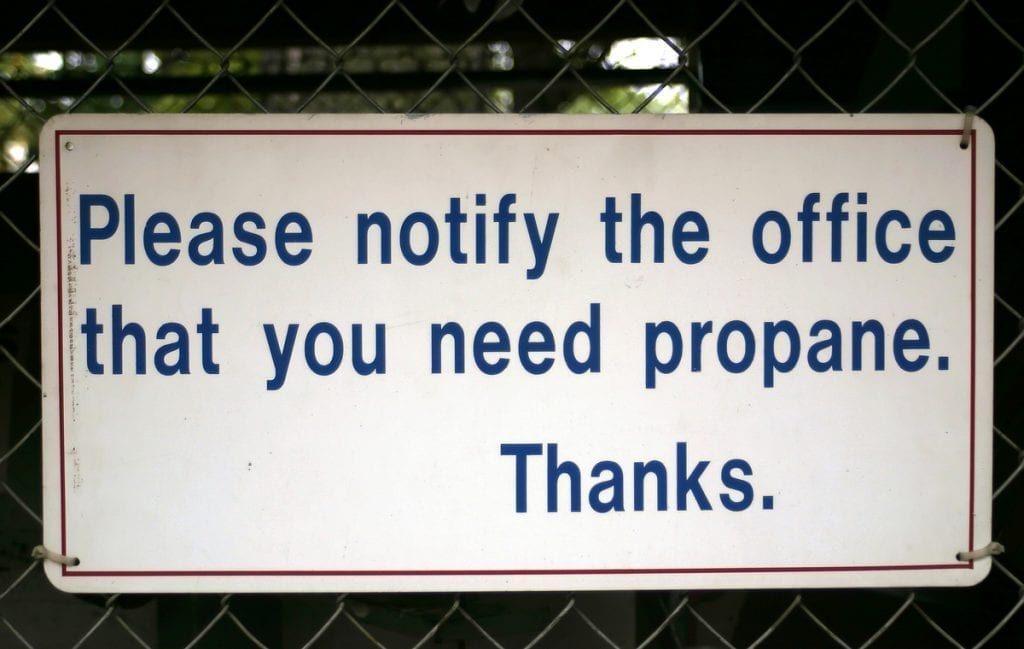Why Use Propane-Powered Equipment?

Why Use Propane-Powered Equipment?
Propane is a gas normally compressed and stored as a liquid. It is nontoxic, colorless, and virtually odorless. It offers the same performance characteristics as natural gas. Propane has been used as a transportation fuel since the 1940s and can power light-, medium- and heavy-duty vehicles equipped for its use. When used as vehicle fuel, it is known as propane autogas.
Interest in propane as an alternative fuel stems from its domestic availability, high energy density, clean-burning qualities, and relatively low cost. It also presents no threat to soil, surface water, or groundwater. It is the world’s third most common transportation fuel, behind gasoline and diesel. Its high octane rating makes propane an excellent choice for spark-ignited internal combustion engines. However, it has a lower British thermal unit (BTU) rating than gasoline, so it does take more fuel by volume to drive the same distance. Because of its higher octane rating compared to gasoline, it can be used with higher engine compression ratios and prevents engine knocking.
Propane is stored onboard a vehicle in a tank pressurized to about 150 PSI—about twice the pressure of an inflated truck tire. Under this pressure, propane becomes a liquid with an energy density 270 times greater than its gaseous form. If there is a leak, propane will dissipate into the air. Because it is heavier than air, it will linger in low spots, while compressed natural gas (CNG) is lighter than air and rises.




Propane Is Making Its Way to a Job Site Near You
On most construction sites, diesel remains the predominant power source for vehicles and equipment. But alternatives are creeping in. One that shows significant potential for continued growth is propane.
At first glance, the prospect of widespread use of propane on your projects may seem far-fetched. Yet, propane has been used for decades in various applications and industries. Its reliability as a small engine fuel source has led to a growing number of construction applications being powered by the fuel. And its emissions profile allows it to be used both indoors and out.
Propane is a gas normally compressed and stored as a liquid. It is sometimes known as liquefied petroleum gas (LPG or LP gas). It emits 17% fewer greenhouse gases and 50% less carbon monoxide than gasoline. Propane equipment also emits 19% less nitrogen oxide (NOx) than equipment fueled by gasoline.
Propane’s portability, low emissions, and ease of refueling make it an effective choice for construction job sites. On sites that aren’t yet connected to utilities or are located beyond the electrical grid, it enables work to be completed without the need to bring in an alternative power source for electric-powered equipment.

Message Us
Get in touch below to learn how Green Umbrella equipment cuts labor, downtime, and environmental impact.
CALL US AT (844) 200-7336
OFFICE LOCATION
20 Jetview Drive
Rochester, NY 14624
OPEN HOURS
M-F: 9am – 5pm
info@greenumbrellasystems.com
[et_pb_section fb_built=”1″ admin_label=”Hero” _builder_version=”4.16″ use_background_color_gradient=”on” background_color_gradient_type=”circular” background_color_gradient_direction_radial=”top right” background_color_gradient_stops=”rgba(0,96,25,0.45) 10%|rgba(33,25,21,0) 100%” background_color_gradient_overlays_image=”on” background_color_gradient_start=”rgba(0,96,25,0.45)” background_color_gradient_start_position=”10%” background_color_gradient_end=”rgba(33,25,21,0)” background_image=”https://dev.greenumbrellasystems.com/wp-content/uploads/2019/12/Propane__Exceptional_Energy.jpg” background_size=”contain” height=”400px” custom_padding=”80px|0|0||false|false” global_colors_info=”{}”][/et_pb_section][et_pb_section fb_built=”1″ admin_label=”Services Header” _builder_version=”4.16″ custom_padding=”0|0px|0|0px|false|false” global_colors_info=”{}”][et_pb_row column_structure=”2_3,1_3″ use_custom_gutter=”on” gutter_width=”1″ padding_top_bottom_link_2=”true” padding_left_right_link_2=”true” _builder_version=”4.16″ custom_padding=”0|0px|27px|0px|false|false” animation_style=”slide” animation_direction=”top” animation_intensity_slide=”20%” locked=”off” global_colors_info=”{}”][et_pb_column type=”2_3″ _builder_version=”4.16″ custom_padding=”|||” global_colors_info=”{}” custom_padding__hover=”|||”][et_pb_text _builder_version=”4.18.0″ text_font=”||||||||” ul_font=”||||||||” ol_font=”||||||||” quote_font=”||||||||” header_font=”||||||||” header_font_size=”52px” header_2_font=”|800|||||||” header_2_font_size=”24px” header_2_line_height=”1.8em” header_3_font=”||||||||” header_4_font=”|800||on|||||” header_4_font_size=”16px” header_4_letter_spacing=”0.5px” header_4_line_height=”1.7em” header_5_font=”||||||||” header_6_font=”||||||||” background_color=”#ffffff” padding_1_last_edited=”on|desktop” custom_padding=”91px|50px|91px|50px|true|true” custom_padding_tablet=”” custom_padding_phone=”20px|10%|20px|10%|true|true” custom_padding_last_edited=”on|phone” header_2_font_size_tablet=”” header_2_font_size_phone=”18px” header_2_font_size_last_edited=”on|phone” locked=”off” global_colors_info=”{}”]
Why Use Propane-Powered Equipment?
[/et_pb_text][/et_pb_column][et_pb_column type=”1_3″ _builder_version=”4.16″ custom_padding=”50px|50px|50px|50px” custom_padding_tablet=”” custom_padding_phone=”20px|10%|20px|10%|true|true” custom_padding_last_edited=”on|phone” global_colors_info=”{}” padding_phone=”20px|10%|20px|10%|true|true” padding_last_edited=”on|phone” custom_padding__hover=”|||”][et_pb_image src=”https://dev.greenumbrellasystems.com/wp-content/uploads/2019/12/Depositphotos_27513245_l-2015.jpg” _builder_version=”4.16″ width=”70.4%” global_colors_info=”{}”][/et_pb_image][/et_pb_column][/et_pb_row][/et_pb_section][et_pb_section fb_built=”1″ _builder_version=”4.16″ custom_padding=”0px||0px|||” global_colors_info=”{}”][et_pb_row _builder_version=”4.16″ global_colors_info=”{}”][et_pb_column type=”4_4″ _builder_version=”4.16″ global_colors_info=”{}”][et_pb_text _builder_version=”4.18.0″ global_colors_info=”{}”]
Propane is a gas normally compressed and stored as a liquid. It is nontoxic, colorless, and virtually odorless. It offers the same performance characteristics as natural gas. Propane has been used as a transportation fuel since the 1940s and can power light-, medium- and heavy-duty vehicles equipped for its use. When used as vehicle fuel, it is known as propane autogas.
Interest in propane as an alternative fuel stems from its domestic availability, high energy density, clean-burning qualities, and relatively low cost. It also presents no threat to soil, surface water, or groundwater. It is the world’s third most common transportation fuel, behind gasoline and diesel. Its high octane rating makes propane an excellent choice for spark-ignited internal combustion engines. However, it has a lower British thermal unit (BTU) rating than gasoline, so it does take more fuel by volume to drive the same distance. Because of its higher octane rating compared to gasoline, it can be used with higher engine compression ratios and prevents engine knocking.
Propane is stored onboard a vehicle in a tank pressurized to about 150 PSI—about twice the pressure of an inflated truck tire. Under this pressure, propane becomes a liquid with an energy density 270 times greater than its gaseous form. If there is a leak, propane will dissipate into the air. Because it is heavier than air, it will linger in low spots, while compressed natural gas (CNG) is lighter than air and rises.
[/et_pb_text][/et_pb_column][/et_pb_row][/et_pb_section][et_pb_section fb_built=”1″ _builder_version=”4.16″ custom_padding=”0px||0px|||” global_colors_info=”{}”][et_pb_row column_structure=”1_3,1_3,1_3″ _builder_version=”4.16″ global_colors_info=”{}”][et_pb_column type=”1_3″ _builder_version=”4.16″ global_colors_info=”{}”][et_pb_image src=”https://dev.greenumbrellasystems.com/wp-content/uploads/2019/11/Alternative-Fuel-GCX-Grinder-Med-1100×573.jpg” _builder_version=”4.16″ max_height=”185px” global_colors_info=”{}”][/et_pb_image][/et_pb_column][et_pb_column type=”1_3″ _builder_version=”4.16″ global_colors_info=”{}”][et_pb_image src=”https://dev.greenumbrellasystems.com/wp-content/uploads/2019/11/Propane-CMYK-H-CAE-tag-R.jpg” _builder_version=”4.16″ max_height=”185px” custom_padding=”32px|||||” global_colors_info=”{}”][/et_pb_image][/et_pb_column][et_pb_column type=”1_3″ _builder_version=”4.16″ global_colors_info=”{}”][et_pb_image src=”https://dev.greenumbrellasystems.com/wp-content/uploads/2019/12/Propane-1.jpg” _builder_version=”4.16″ max_height=”185px” global_colors_info=”{}”][/et_pb_image][/et_pb_column][/et_pb_row][/et_pb_section][et_pb_section fb_built=”1″ _builder_version=”4.16″ custom_padding=”0px|||||” global_colors_info=”{}”][et_pb_row _builder_version=”4.16″ global_colors_info=”{}”][et_pb_column type=”4_4″ _builder_version=”4.16″ global_colors_info=”{}”][et_pb_text _builder_version=”4.18.0″ global_colors_info=”{}”]
Propane Is Making Its Way to a Job Site Near You
On most construction sites, diesel remains the predominant power source for vehicles and equipment. But alternatives are creeping in. One that shows significant potential for continued growth is propane.
At first glance, the prospect of widespread use of propane on your projects may seem far-fetched. Yet, propane has been used for decades in various applications and industries. Its reliability as a small engine fuel source has led to a growing number of construction applications being powered by the fuel. And its emissions profile allows it to be used both indoors and out.
Propane is a gas normally compressed and stored as a liquid. It is sometimes known as liquefied petroleum gas (LPG or LP gas). It emits 17% fewer greenhouse gases and 50% less carbon monoxide than gasoline. Propane equipment also emits 19% less nitrogen oxide (NOx) than equipment fueled by gasoline.
Propane’s portability, low emissions, and ease of refueling make it an effective choice for construction job sites. On sites that aren’t yet connected to utilities or are located beyond the electrical grid, it enables work to be completed without the need to bring in an alternative power source for electric-powered equipment.
[/et_pb_text][/et_pb_column][/et_pb_row][/et_pb_section][et_pb_section fb_built=”1″ admin_label=”Contact Banner” _builder_version=”4.16″ background_color=”#006619″ custom_padding=”20px|0px|20px|0px|true|false” animation_style=”slide” animation_direction=”bottom” global_colors_info=”{}”][et_pb_row column_structure=”1_2,1_2″ _builder_version=”4.16″ global_colors_info=”{}”][et_pb_column type=”1_2″ _builder_version=”4.16″ custom_padding=”|||” global_colors_info=”{}” custom_padding__hover=”|||”][et_pb_text _builder_version=”4.18.0″ text_font=”||||||||” quote_font=”||||||||” header_font=”||||||||” header_2_font=”|800|||||||” header_2_font_size=”24px” header_2_line_height=”1.8em” header_3_font=”||||||||” header_4_font=”|800||on|||||” header_4_font_size=”16px” header_4_letter_spacing=”0.5px” header_4_line_height=”1.7em” background_layout=”dark” custom_padding=”|||” header_2_font_size_tablet=”” header_2_font_size_phone=”18px” header_2_font_size_last_edited=”on|phone” locked=”off” global_colors_info=”{}”]
Message Us
Get in touch below to learn how Green Umbrella equipment cuts labor, downtime, and environmental impact.
[/et_pb_text][/et_pb_column][et_pb_column type=”1_2″ _builder_version=”4.16″ custom_padding=”|||” global_colors_info=”{}” custom_padding__hover=”|||”][et_pb_text _builder_version=”4.16″ text_font=”||||||||” quote_font=”||||||||” header_font=”||||||||” header_2_font=”|800||on|||||” header_2_font_size=”44px” header_2_letter_spacing=”1px” header_2_line_height=”1.8em” header_3_font=”||||||||” header_4_font=”|800||on|||||” header_4_font_size=”16px” header_4_letter_spacing=”0.5px” header_4_line_height=”1.7em” text_orientation=”right” background_layout=”dark” custom_padding=”|||” header_2_font_size_tablet=”” header_2_font_size_phone=”18px” header_2_font_size_last_edited=”on|phone” locked=”off” global_colors_info=”{}”]
Call Us
(844) 200-7336
[/et_pb_text][/et_pb_column][/et_pb_row][/et_pb_section][et_pb_section fb_built=”1″ admin_label=”Footer” _builder_version=”4.16″ use_background_color_gradient=”on” background_color_gradient_type=”circular” background_color_gradient_direction_radial=”top right” background_color_gradient_stops=”#210b00 10%|rgba(33,25,21,0) 100%” background_color_gradient_overlays_image=”on” background_color_gradient_start=”#210b00″ background_color_gradient_start_position=”10%” background_color_gradient_end=”rgba(33,25,21,0)” background_image=”https://dev.greenumbrellasystems.com/wp-content/uploads/2019/12/Depositphotos_40063179_xl-2015-scaled.jpg” custom_padding=”100px||100px||true|false” global_colors_info=”{}”][et_pb_row column_structure=”2_3,1_3″ _builder_version=”4.16″ global_colors_info=”{}”][et_pb_column type=”2_3″ _builder_version=”4.16″ custom_padding=”|||” global_colors_info=”{}” custom_padding__hover=”|||”][et_pb_contact_form captcha=”off” module_id=”et_pb_contact_form_1″ _builder_version=”4.16″ _unique_id=”630fbc96-602e-4d05-a652-52003c34a01d” form_field_background_color=”rgba(0,0,0,0)” form_field_text_color=”#ffffff” form_field_font=”Open Sans||||||||” form_field_font_size=”16px” form_field_line_height=”2em” custom_button=”on” button_text_size=”16px” button_text_color=”#ffffff” button_border_width=”0px” button_border_radius=”0px” button_letter_spacing=”1px” button_font=”Roboto|700||on|||||” button_use_icon=”off” border_width_all=”2px” border_color_all=”rgba(255,255,255,0.4)” form_background_color=”rgba(0,0,0,0)” global_colors_info=”{}”][et_pb_contact_field field_id=”Name” field_title=”Name” _builder_version=”4.16″ global_colors_info=”{}” button_text_size__hover_enabled=”off” button_one_text_size__hover_enabled=”off” button_two_text_size__hover_enabled=”off” button_text_color__hover_enabled=”off” button_one_text_color__hover_enabled=”off” button_two_text_color__hover_enabled=”off” button_border_width__hover_enabled=”off” button_one_border_width__hover_enabled=”off” button_two_border_width__hover_enabled=”off” button_border_color__hover_enabled=”off” button_one_border_color__hover_enabled=”off” button_two_border_color__hover_enabled=”off” button_border_radius__hover_enabled=”off” button_one_border_radius__hover_enabled=”off” button_two_border_radius__hover_enabled=”off” button_letter_spacing__hover_enabled=”off” button_one_letter_spacing__hover_enabled=”off” button_two_letter_spacing__hover_enabled=”off” button_bg_color__hover_enabled=”off” button_one_bg_color__hover_enabled=”off” button_two_bg_color__hover_enabled=”off”][/et_pb_contact_field][et_pb_contact_field field_id=”Email” field_title=”Email Address” field_type=”email” _builder_version=”4.16″ global_colors_info=”{}” button_text_size__hover_enabled=”off” button_one_text_size__hover_enabled=”off” button_two_text_size__hover_enabled=”off” button_text_color__hover_enabled=”off” button_one_text_color__hover_enabled=”off” button_two_text_color__hover_enabled=”off” button_border_width__hover_enabled=”off” button_one_border_width__hover_enabled=”off” button_two_border_width__hover_enabled=”off” button_border_color__hover_enabled=”off” button_one_border_color__hover_enabled=”off” button_two_border_color__hover_enabled=”off” button_border_radius__hover_enabled=”off” button_one_border_radius__hover_enabled=”off” button_two_border_radius__hover_enabled=”off” button_letter_spacing__hover_enabled=”off” button_one_letter_spacing__hover_enabled=”off” button_two_letter_spacing__hover_enabled=”off” button_bg_color__hover_enabled=”off” button_one_bg_color__hover_enabled=”off” button_two_bg_color__hover_enabled=”off”][/et_pb_contact_field][et_pb_contact_field field_id=”Message” field_title=”Message” field_type=”text” fullwidth_field=”on” _builder_version=”4.16″ global_colors_info=”{}” button_text_size__hover_enabled=”off” button_one_text_size__hover_enabled=”off” button_two_text_size__hover_enabled=”off” button_text_color__hover_enabled=”off” button_one_text_color__hover_enabled=”off” button_two_text_color__hover_enabled=”off” button_border_width__hover_enabled=”off” button_one_border_width__hover_enabled=”off” button_two_border_width__hover_enabled=”off” button_border_color__hover_enabled=”off” button_one_border_color__hover_enabled=”off” button_two_border_color__hover_enabled=”off” button_border_radius__hover_enabled=”off” button_one_border_radius__hover_enabled=”off” button_two_border_radius__hover_enabled=”off” button_letter_spacing__hover_enabled=”off” button_one_letter_spacing__hover_enabled=”off” button_two_letter_spacing__hover_enabled=”off” button_bg_color__hover_enabled=”off” button_one_bg_color__hover_enabled=”off” button_two_bg_color__hover_enabled=”off”][/et_pb_contact_field][/et_pb_contact_form][/et_pb_column][et_pb_column type=”1_3″ _builder_version=”4.16″ custom_padding=”|||” global_colors_info=”{}” custom_padding__hover=”|||”][et_pb_blurb title=”Office Location” use_icon=”on” font_icon=”||divi||400″ icon_color=”#ffffff” icon_placement=”left” content_max_width=”1100px” _builder_version=”4.16″ header_font=”|800||on|||||” header_font_size=”16px” header_letter_spacing=”0.5px” header_line_height=”1.7em” body_font=”Open Sans||||||||” body_line_height=”2em” background_layout=”dark” locked=”off” global_colors_info=”{}”]
20 Jetview Drive
Rochester, NY 14624
[/et_pb_blurb][et_pb_blurb title=”Office Hours” use_icon=”on” font_icon=”||divi||400″ icon_color=”#ffffff” icon_placement=”left” content_max_width=”1100px” _builder_version=”4.18.0″ header_font=”|800||on|||||” header_font_size=”16px” header_letter_spacing=”0.5px” header_line_height=”1.7em” body_font=”Open Sans||||||||” body_line_height=”2em” background_layout=”dark” hover_enabled=”0″ locked=”off” global_colors_info=”{}” sticky_enabled=”0″]
Monday to Friday
9 AM – 5 PM
[/et_pb_blurb][et_pb_blurb title=”Email” use_icon=”on” font_icon=”||divi||400″ icon_color=”#ffffff” icon_placement=”left” content_max_width=”1100px” _builder_version=”4.16″ header_font=”|800||on|||||” header_font_size=”16px” header_letter_spacing=”0.5px” header_line_height=”1.7em” body_font=”Open Sans||||||||” body_line_height=”2em” background_layout=”dark” locked=”off” global_colors_info=”{}”]
info@dev.greenumbrellasystems.com
[/et_pb_blurb][/et_pb_column][/et_pb_row][/et_pb_section]

